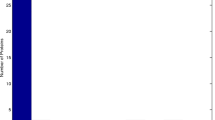Abstract
Molecular similarity index measures the similarity between two molecules. Computing the optimal similarity index is a hard global optimization problem. Since the objective function value is very hard to compute and its gradient vector is usually not available, previous research has been based on non-gradient algorithms such as random search and the simplex method. In a recent paper, McMahon and King introduced a Gaussian approximation so that both the function value and the gradient vector can be computed analytically. They then proposed a steepest descent algorithm for computing the optimal similarity index of small molecules. In this paper, we consider a similar problem. Instead of computing atom-based derivatives, we directly compute the derivatives with respect to the six free variables describing the relative positions of the two molecules.. We show that both the function value and gradient vector can be computed analytically and apply the more advanced BFGS method in addition to the steepest descent algorithm. The algorithms are applied to compute the similarities among the 20 amino acids and biomolecules like proteins. Our computational results show that our algorithm can achieve more accuracy than previous methods and has a 6-fold speedup over the steepest descent method.
Similar content being viewed by others
References
Burt, C., Richards, W.G. and Huxley, P. (1990), The Application of Molecular Similarity Calculations, Journal of Computational Chemistry 11, 1139-1146.
Carbo, R., Leyda, L. and Arnau, M. (1980), How Similar is a Molecule to Another?, International Journal of Quantum Chemistry 17, 1185-1189.
Coleman, T., Shalloway, D. and Wu, Z. (1993), Isotropic Effective Energy Simulated Annealing Searches for Low Energy Molecular Cluster States, Computational Optimization and Applications 2, 145-170.
Dean, P.M. (ed.) (1995), Molecular Similarity in Drug Design, Chapman Hall, London.
Fletcher, R. (1987), Practical Methods of Optimization, 2nd ed., John Wiley, Chichester.
Johnson, M.A. and Maggiora, G.M. (1990), Concepts and Application of Molecular Similarity, Wiley, New York.
Hodgkin, E.E. and Richards, W.G. (1987), Molecular Similarity Based on Electrostatic Potential and Electric Field, International Journal of Quantum Chemistry, Quantum Biology Symposium 14, 105-110.
Lee, C. and Smithline, S. (1994), An Approach to Molecular Similarity Using Density Functional Theory, Journal of Physical Chemistry 98, 1135-1138.
Liu, D.C. and Nocedal, J. (1989), On the Limited Memory BFGS Method for Large Scale Optimization, Mathematical Programming 45, 503-528.
Mark, A.E., van Gunstern, W.F., King, P.M. (1994), Fundamentals of Drug Design from a Biophysical Viewpoint, Quarterly Reviews of Biophysics 27, 435.
Maranas, C.D. and Floudas, C.A. (1994), Global Minimum Potential Energy Conformations of Small Molecules, Journal of Global Optimization 4, 135-170.
McCammon, J.A., Wolynes, P.G. and Karplus, M. (1979), Picosecond Dynamics of Tyrosine Side Chains in Proteins, Biochemistry 18, 927-942.
McMahon, A.J. and King, P.M. (1997), Optimization of Carbo Molecular Similarity Index Using Gradient Methods, Journal of Computational Chemistry 18, 151-158.
Pardalos, P.M., Shalloway, D. and Xue, G.L. (1994), Optimization Methods for Computing Global Minima of Non-convex Potential Energy Functions, Journal of Global Optimization 4, 117-133.
Richard, A.M. and Rabinowitz, J.R. (1987), Modified Molecular Charge Similarity Indices for Choosing Molecular Analogues, International Journal of Quantum Chemistry 31, 309-323.
Shalloway, D. (1992), Application of the Renormalization Group to Deterministic Global Minimization of Molecular Conformation Energy Functions, Journal of Global Optimization 2, 281-311.
Strnad, M. and Ponec, R. (1994), Novel Approach to Molecular Similarity: Second-order Similarity Indices from Geminal Expansion of Pair Densities, International Journal of Quantum Chemistry 49, 35-43.
Author information
Authors and Affiliations
Rights and permissions
About this article
Cite this article
Ling, L., Xue, G. Optimization of Molecular Similarity Index with Applications to Biomolecules. Journal of Global Optimization 14, 299–312 (1999). https://doi.org/10.1023/A:1008206921290
Issue Date:
DOI: https://doi.org/10.1023/A:1008206921290




